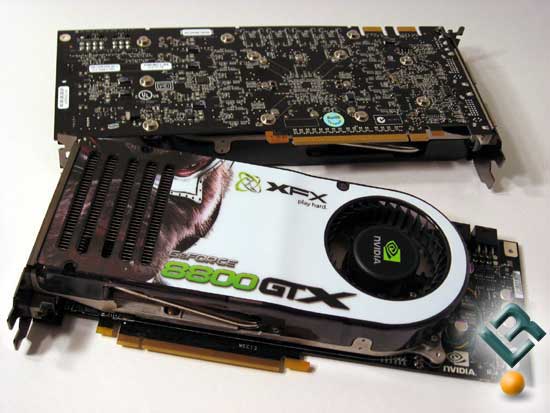XFX GeForce 8800 GTX SLI Video Card Review
Introduction

The launch of the latest flagship 8800 GTX has many drooling at incredible frame rates the card provides in today’s games and the future DirectX 10 prowess the card promises. When the GeForce 8800 GTX was released in November we had one card available to benchmark and found that it was the fastest card around. The very next day LR publied an editorial that showed a few benchmarks on a $4,000+ dream machine with a pair of XFX 8800 GTX graphics card running SLI. It was in this review we showed that a pair of 8800 GTX graphics cards would destroy ATI’s X1950 XTX Crossfire setup in games like F.E.A.R. and Quake 4, but was limited by BIOS issues as quad-core processors wouldn’t work on the NVIDIA 680i SLI motherboard. A few days later an article on the 8800 GTX resistor change was published, which found that many enthusiasts had video cards that needed to be RMA’d. Last month we were benchmarking a system with BIOS issues uses cards that were fixed by hand on older drivers. Today we are taking a look at what kind of performance you can expect to get from 2 of these bad boys linked together using an older AMD Socket 939 platform, which is something more along the lines of what people are running.
While most will only be able to dream of a pair of 8800 GTX in SLI, a lucky few will be able to afford them. Being able to afford the graphics cards is only part of the battle as NVIDIA strongly suggest using a power supply with at least an output of 750W to power dual GeForce 8800 GTX. The need for a new power supply is required because it must be capable of delivering at least 30 Amps on the +12V rail and have 4 PCI-E connectors because two of these beasts eat up gobs of power. We strongly suggest looking at 13 certified SLI-Ready that have passed testing by NVIDIA and are known to power a system like this. For those of you that just recently upgraded their power supply don’t worry as it might still work. When we last talked to Corsair’s product manager about their modular HX620W power supply he informed us that those that already bougt one can get additional 6-pin PCIe power headers and be able to use this PSU on a system with 8800 GTX’s. This is because the power supply is modular and the fact that it has a 50Amp rating on the +12V rail. The take home message here is make sure you have to run out and buy a new $300-$500 PSU or just pick up a set of modular cables. Unfortunately those aren’t the only expenses for getting the most out of this kind of set up, but we’ll get to that later.
The cards that are being used today have been provided by the good guys at XFX and have the updated resistor and came in the retail box. All standard cards come at the same 575MHz Core and 1.8 GHz Memory clock speeds and almost all have identical heat sink/fan combos. In our initial review of the 8800 GTX we praised the heat sink but after running them in SLI you quickly find out that any other add-in cards become heat magnets because of the three vent holes in the top of the 8800 series heat sink. That is something you X-Fi and PhysX owners should take note of. Also of note is just how much heat is being exhausted. An idle temp of 50c and load in the low 70c mean that you need exceptional cooling not just in your case, but also the room your computer is in!
When it comes to price you’re looking at roughly $620 a piece for these monsters. Fortunately XFX provides a double lifetime warranty for those wanting a little piece of mind for their ~$1200 investment. XFX has recognized just how many early adopters are out there and the 8800 GTX is a perfect example of a card that someone that lives on the bleeding edge has to have. With the purchase of an XFX card you can be sure that you and the person you decide to sell it to will be well covered.
Enough with all of the reality talk, let’s get to the benchmarks!

Comments are closed.